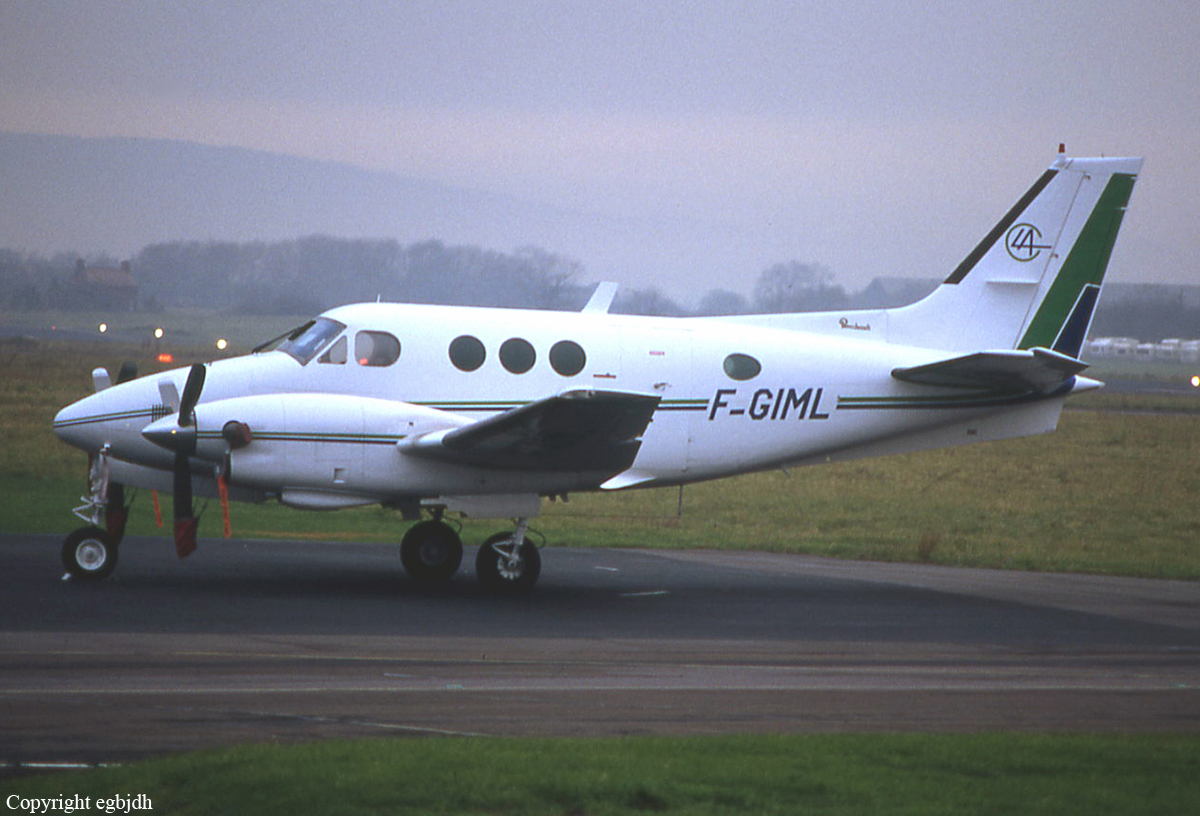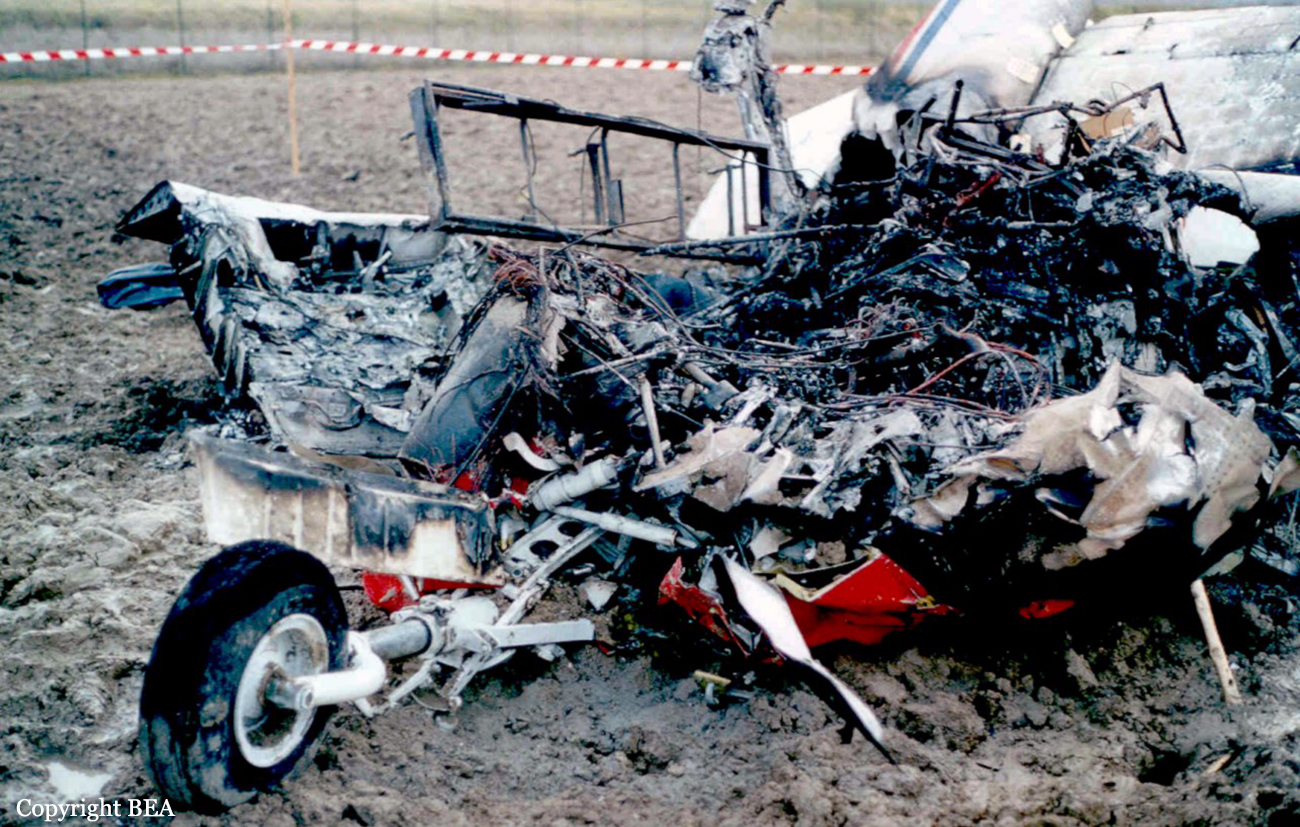Country
Crash of a Beechcraft F90 King Air in Lynchburg
Date & Time:
Nov 24, 2000 at 1151 LT
Registration:
N94U
Survivors:
Yes
Schedule:
Lynchburg - Lynchburg
MSN:
LA-124
YOM:
1981
Crew on board:
1
Crew fatalities:
Pax on board:
1
Pax fatalities:
Other fatalities:
Total fatalities:
0
Captain / Total hours on type:
250.00
Aircraft flight hours:
6788
Circumstances:
The pilot was conducting a post-maintenance test flight. An overhauled engine had been installed on the right side of the airplane, and both propeller assemblies had been subsequently re-rigged. Ground checks were satisfactory, although the right engine propeller idled 90-100 rpm higher than the left engine propeller. Test flight engine start and run-up were conducted per the checklist, with no anomalies noted. Takeoff ground roll and initial climb were normal; however, when the airplane reached about 100 feet, it stopped climbing and lost airspeed. The pilot could not identify the malfunction, and performed a forced landing to rough, hilly terrain. Upon landing, the landing gear collapsed and the engine nacelles were compromised. The airplane subsequently burned. Post-accident examination of the airplane revealed that the propeller beta valves of both engines were improperly rigged, and that activation of the landing gear squat switch at takeoff resulted in both propellers going into feather. The maintenance personnel did not have rigging experience in airplane make and model. As a result of the investigation, the manufacturer clarified maintenance manual and pilot handbook procedures.
Probable cause:
Improper rigging of both propeller assemblies by maintenance personnel, which resulted in the inadvertent feathering of both propellers after takeoff. Factors included a lack of rigging experience in airplane make and model by maintenance personnel, unclear maintenance manual information, and unsuitable terrain for the forced landing.
Final Report:
Crash of a Beechcraft E90 King Air in Reims: 2 killed
Date & Time:
Nov 13, 2000 at 1338 LT
Registration:
F-GIML
Survivors:
No
Schedule:
Paris - Reims
MSN:
LW-180
YOM:
1976
Flight number:
CPH030
Crew on board:
2
Crew fatalities:
Pax on board:
0
Pax fatalities:
Other fatalities:
Total fatalities:
2
Captain / Total hours on type:
2000.00
Copilot / Total hours on type:
670
Aircraft flight hours:
8772
Aircraft flight cycles:
8441
Circumstances:
The twin engine aircraft departed Paris-Le Bourget Airport at 1309LT on a flight to Reims-Champagne with two pilots on board, one instructor and one pilot that should complete a transition program. While descending at an altitude of 2,000 to Reims-Prunay Airport, the crew informed ATC that he would perform an exercise consisting of a go-around procedure with the simulation of an engine failure. On a left downwind approach to runway 25, the crew started the exercise when the aircraft rolled to the left, lost height and crashed in an open field, bursting into flames. The wreckage was found 425 metres short of runway 25 and both pilots were killed.
Probable cause:
The accident resulted from the performance of a single-engine go-around exercise at low height, in an unfavorable configuration.
Final Report:


Crash of a Beechcraft E90 King Air near Goiânia
Date & Time:
May 30, 2000 at 1620 LT
Registration:
PP-EFC
Survivors:
Yes
Schedule:
Itapuranga - Goiânia
MSN:
LW-15
YOM:
1972
Crew on board:
2
Crew fatalities:
Pax on board:
7
Pax fatalities:
Other fatalities:
Total fatalities:
0
Captain / Total hours on type:
2000.00
Copilot / Total hours on type:
500
Circumstances:
The twin engine aircraft departed a private strip in Itapuranga on a flight to Goiânia, carrying seven passengers and two pilots. About 10 minutes after takeoff, while in cruising altitude, the captain informed ATC about the failure of the right engine. Because the flight was short (25 minutes in total), he decided to continue to Goiânia. Twelve minutes later, the left engine failed as well. The crew declared an emergency and as he was unable to reach Goiânia Airport, he attempted an emergency landing in a pasture. The aircraft crash landed 13 km short of runway 14 threshold. All nine occupants were rescued, among them seven were injured, three seriously.
Probable cause:
Both engines failed 12 minutes apart due to fuel exhaustion. The following contributing factors were identified:
- Fuel tanks were empty,
- The fuel quantity was insufficient to cover the requested flying distance,
- Poor flight preparation and planning,
- Complacency on part of the copilot,
- Wrong decisions on part of the captain,
- Failures in the organization of flights within the operations of the Government of the State of Goiás,
- Miscalculations in fuel consumption.
- Operating an airplane with faulty fuel gauges,
- Failures in monitoring related to flight safety culture,
- Poor crew resources management,
- Poor crew coordination,
- Lack of crew interactions.
- Fuel tanks were empty,
- The fuel quantity was insufficient to cover the requested flying distance,
- Poor flight preparation and planning,
- Complacency on part of the copilot,
- Wrong decisions on part of the captain,
- Failures in the organization of flights within the operations of the Government of the State of Goiás,
- Miscalculations in fuel consumption.
- Operating an airplane with faulty fuel gauges,
- Failures in monitoring related to flight safety culture,
- Poor crew resources management,
- Poor crew coordination,
- Lack of crew interactions.
Final Report:
Crash of a Beechcraft C90 King Air in Bursa: 1 killed
Date & Time:
Mar 21, 2000
Registration:
TC-LMK
Survivors:
Yes
Schedule:
Ankara - Bursa
MSN:
LJ-1080
YOM:
1984
Crew on board:
1
Crew fatalities:
Pax on board:
4
Pax fatalities:
Other fatalities:
Total fatalities:
1
Circumstances:
On final approach to Bursa-Yenisehir Airport, the pilot encountered poor weather conditions. Due to low visibility, he was unable to establish a visual contact with the approach and runway lights and initiated a go-around procedure. While completing a circuit, the twin engine aircraft struck the top of a hill located near the airport and crashed. A passenger was killed while four other occupants were injured.

Crash of a Beechcraft C90 King Air in Güdül: 4 killed
Date & Time:
Jan 24, 2000
Registration:
TC-DBZ
Survivors:
No
Schedule:
Ankara - Istanbul
MSN:
LJ-703
YOM:
1977
Crew on board:
1
Crew fatalities:
Pax on board:
3
Pax fatalities:
Other fatalities:
Total fatalities:
4
Circumstances:
The twin engine airplane departed Ankara-Esenboğa Airport on a flight to Istanbul with three passengers and one pilot on board, among the operator's President. Few minutes after takeoff, while flying in poor weather conditions due to snow falls, the aircraft went out of control and crashed in a field located in Güdül, about 65 km west of Ankara-Esenboğa Airport. All four occupants were killed.
Crash of a Beechcraft C90 King Air in Somerset: 4 killed
Date & Time:
Jan 18, 2000 at 1202 LT
Registration:
N74CC
Survivors:
No
Schedule:
Philadelphia - Columbus - Somerset
MSN:
LJ-620
YOM:
1974
Crew on board:
1
Crew fatalities:
Pax on board:
3
Pax fatalities:
Other fatalities:
Total fatalities:
4
Captain / Total hours on type:
1270.00
Aircraft flight hours:
9118
Circumstances:
The pilot requested and received clearance to execute the SDF approach, and was instructed to maintain 4,000 feet until established on the approach. Radar data revealed the airplane was never established on the approach, and started to descend before reaching the IAF. The airplane passed the IAF at 2,900 feet, and continued in a descending left hand turn into unprotected airspace. The airplane disappeared from radar at 1,900 feet, as it completed 180 degrees of turn. The turn did not match any of the four instrument approaches to the airport. The airplane struck a guy wire on a lighted communications antenna 3.3 MN southeast of the airport on a heading of 360 degrees. No evidence of a mechanical failure or malfunction of the airplane or its systems was found. A flight check by the FAA confirmed no navigation signal was received for the approach, which had been turned off and listed as out of service for over 4 years. In addition, the pilot did not report the lack of a navigation signal to ATC or execute a missed approach. Interviews disclosed the ATC controller failed to verify the approach was in service before issuing the approach clearance.
Probable cause:
The failure of the pilot to follow his approach clearance, and subsequent descent into unprotected airspace which resulted in a collision with the guy wire. Factors were the failure of the air traffic controller to verify the approach he cleared the pilot to conduct was in service, and the clouds which restricted the visibility of the communications antenna.
Final Report:




